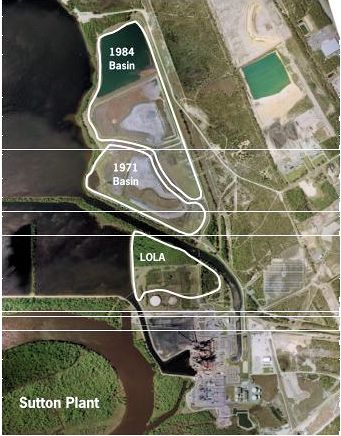 About 7.2 million tons of coal ash are stored in three ponds at Duke Energy’s L.V. Sutton power plant near Wilmington. The ponds were built in 1971 and 1984. Before then, the ash was intermittently stored in an area Duke calls “lay of the land area,” or LOLA. Photo: Duke Energy |
RALEIGH — Coal ash removal from waste basins at Duke Energy’s L.V. Sutton plant in New Hanover County and three other key sites in the state, could start as early as next April if the utility gets the green light on a new set of coal ash plans announced earlier this month.
Duke is trying to meet a legislative deadline of August 1, 2019, for cleanup at the four sites that were identified as top priorities by the company and state regulators.
Supporter Spotlight
In the first phase of the plan, estimated to take 12-18 months after all permits are in hand, Duke would use trains to ship two million tons of ash from the Sutton plant to lined landfills that are part of a project to reclaim clay mines near Sanford in Lee County and near Moncure in adjoining Chatham County. A million tons of ash from the company’s Riverbend plant in Gaston County will also be at the mines.
The first phase also includes shipping about half of the remaining coal ash from the Dan River power plant in Eden to a new lined landfill in Jetersburg, Va. The Eden plant was the site of the February spill that focused attention on the 32 coal-ash ponds at 14 Duke power plants in the state.
The company will also continue shipping ash from its power plant in Asheville to the city’s airport where it will be used as fill for a new airport runway. Duke plans to store any leftover ash at a new lined landfill near the power plant.
The Sutton plant, which stopped burning coal in 2013, has three coal-ash basins. The oldest, built in 1971, holds roughly 3.5 million tons of ash, which was a residue of coal combustion. A newer basin, built in 1984, holds about 2.8 million tons. Another site on the property, thought to be partly used as an ash basin in 1954 and 1972, could hold as much as another 840,000 tons of coal ash.
If done right, it would be a win for those fighting to get the coal ash at Sutton out of the unlined basins away from groundwater and nearby Sutton Lake, a major recreational fishing area, said Frank Holleman, one of the lead attorneys at the Southern Environmental Law Center working on coal ash litigation, of the Sutton plan.
Supporter Spotlight
“In concept, it could be an appropriate place to put the ash,” he said of the plan to use the clay mines.
In addition to the lining, the clay, which leaks less than other soils, would act as another buffer preventing contact with groundwater.
Mike Giles, an N.C. Coastal Federation Coastal advocate based in Wrightsville Beach, said how well the ash is isolated from groundwater at the clay mines will be important as well as how carefully it is moved.
“We have to make sure the activity isn’t going to make the groundwater contamination worse,” he said.
Getting the green light for the clay mines project may not be so easy, Giles noted. Residents recently turned out at a meeting to tell Lee County commissioners they would fight the plan.
A Cooling Basin No More
 Charah, a company based in Louisville, Ky., could dispose of much of the coal ash at the Sutton plant. Here, company workers spread ash over a liner. Photo: Charah |
One twist on the story at Sutton is the recent state reclassification of Sutton Lake from a cooling basin for the power plant to a public trust water, a move that environmentalists urged for years.
Tom Reeder, director of the N.C. Division of Water Resources, notified Duke of the reclassification in a Nov. 5 letter. The change, Reeder noted, meant that the company would need to revise its wastewater discharge permits.
The move reverses longstanding state policy. As late as December 2011, when the most recent discharge permit was approved, the N.C. Department of Environment and Natural Resources, or DENR, had upheld the cooling basin classification.
“I recognize that this determination is a departure from prior determinations made by DENR,” Reeder said in the letter.
Holleman said the change corrects a decision that never made sense. The law center sued last year to force the state to change the classification of the 1,100 acre lake, which is managed as a state game land and includes a new, state-built $3 million fishing dock.
“It’s a major victory,” Holleman said. “Sutton Lake is an important recreation and food resource and now it will be protected like any of the state’s rivers and lakes. There’s absolutely no question that it is waters of the state and Duke has treated it as wastewater lagoon.”
He said several studies, including extensive work by Wake Forest University to document the effects of high levels of selenium in the lake, underline the result of years of lax enforcement.
The change affects the discharge permits at the plant and the classification of the dams at the Sutton site.
Reeder’s notification triggered a change in the rating of the dams for both the 1971 and 1984 basins, which had been rated “exempt” and “low-hazard” respectively. The two dams are now rated as “high hazard” because failure of the dam could lead to a discharge into Sutton Lake — now a water of the state. The change means the dams will be subject to more frequent inspection.
At the recent inaugural meeting of the state’s new Coal Ash Management Commission, DENR’s Jeff Poupart, a water quality permitting section chief for the Division of Water Resources, said the lake could now be subject to more testing as well. The reclassification, he said, brings the lake in line with state and federal requirements and public perception.
“If you went there, you’d see boats and fishermen and assume it was a water of the state, but it was actually a treatment unit.”

The new Coal Ash Management Commission held its first meeting recently uncertain if it’s legal or will get the money it needs to do its job. Photo: Kirk Ross
Commission Meets Under a Cloud
The Sutton changes and the new Duke excavation and removal plans were among the heaps of information ready for the new Coal Ash Management Commission when it got down to business in Chapel Hill for its first meeting on Nov. 14.
The commission was created by the N.C. General Assembly as part of the Coal Ash Management Act passed in the final days of this year’s session.
The act gives the commission broad authority over cleanup plans throughout the state. Its main role will be in overseeing removal and cleanup plans and prioritizing removal at Duke’s 11 other sites in the state, including the H.F. Lee plant on the Neuse River near Goldsboro.
 Michael Jacobs |
Duke’s recent plans for the four critical sites were filed in response to an executive order by the governor and are not under the purview of the commission.
The nine-member panel is chaired by Michael Jacobs, CEO of a Wilmington-based financial capital company and a professor of finance at UNC-Chapel Hill. During a break in the commission meeting Jacobs told reporters that he had toured the Sutton site and three other locations and said he was struck by how different each one was. “The issues at each one were very different,” he said. “You can’t just lump them altogether.”
The complexity of the review work, he said, will make it hard to meet some of the ambitious goals outlined in this year’s legislation. The commission, which is based in the Division of Emergency Management, has yet to hire an executive director and engineering staff. Its first report to the legislature is due on Dec. 1.
“We’re going to try and move as quickly as we can, but I need some staff before we can make some decisions,” Jacobs said.
The commission is asking for a delay until an executive director and technical director have been in their roles for six months.
But those challenges may pale in comparison to a new one that questions the commission’s existence.
Just days before they met for the first time, Gov. Pat McCrory announced a lawsuit challenging the appointment process for the commission, which has six seats appointed by the legislature and three by McCrory.
In his lawsuit the governor, who was joined in the action by former governors Jim Hunt and James Martin, says that the coal ash commission — and a new oil and gas commission appointed in a similar way — violates the state constitution’s separation of powers requirements.
Last fall, though he praised for parts of the coal ash legislation, McCrory allowed the bill to become law without his signature, citing concerns about the set-up of the commission.
McCrory’s lawsuit follows a similar one filed on behalf of the State Board of Education that challenges the constitutionality of the Rules Review Commission, which also has broad authority over state environmental rule making.
At the coal ash commission’s meeting, Lisa Schneider, who is serving as legal counsel for the group, acknowledged the lawsuit and McCrory’s objection, but said that they are bound to operate under the provisions of the Coal Ash Management Act.
“That’s the law of the land right now,” she said.







